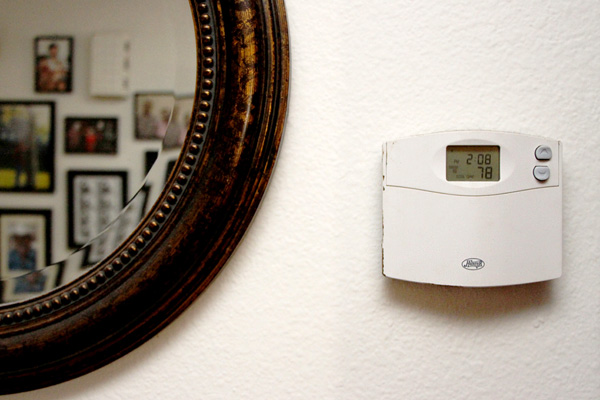Shave Up to 15% Off Your Heating Bill with This Simple Tip
Think you’re saving on your heating bill by keeping it at a constant 68 degrees? You’re not, and here’s why.
It’s easy to imagine your energy bill going sky-high when you hear your furnace fire up. That’s the reason so many people believe keeping a steady temperature of 68 degrees is the key to energy savings. But that’s a myth.
In fact, the lower the temperature, the slower your house loses the heat, according to energy.gov. And that keeps your hard-earned money from floating out the door.
So if you truly want to see your heating bill drop, you need to turn down the temperature another 10 or 15 degrees for eight-hour stretches on a regular basis — like when you’re at work, sleeping, or out of town.
When you return, turn it back up to 68 degrees. Or better yet, take advantage of what a programmable thermostat can do.
In the summer, just flip the strategy:
- Set your AC to 78 degrees when you’re home.
- When you leave, turn the AC off or set your thermostat to a much warmer temperature.
Here are some other misconceptions about and tips for reducing your heating and cooling costs.
Resist the Urge to Crank Up the Thermostat
Turning up the thermostat past your desired setting won’t speed heating. Your furnace works at the same pace regardless of temperature settings. That also applies to your AC; setting the thermostat to its coolest temperature won’t chill your home any faster.
A Programmable Thermostat Doesn’t Automatically Reduce Energy Use
Installing a programmable thermostat with factory settings isn’t going to do you much good. You can only reduce the amount of power your home consumes if you create a personalized heating and cooling program that makes the most of your own energy-saving opportunities.
Programmable thermostats come in four different pre-set schedule styles, so it’s important to pick one that’s in sync with your household’s scheduling needs:
- 7-day programming offers the most flexibility. It allows you to set a different heating and cooling schedule for each day of the week.
- 5-1-1 programming is a good choice if you have a predictable weekday schedule. It lets you set an identical heating and cooling plan Monday through Friday, and a different plan for Saturday and Sunday.
- 5-2 programming is similar to the 5-1-1 programming, except you can only program one heating and cooling schedule for both Saturday and Sunday.
- 1-week programming is a good choice if you stick to the same schedule every day of the week. It allows you to create a single heating and cooling plan that repeats daily.
Bonus tip: When daylight savings comes around, remember to adjust your settings so your heating and cooling program isn’t off by an hour.
Some Smart Thermostats are a Lot Smarter Than Others; Choose Wisely
Smart thermostats aren’t all the same. Sure, all offer Internet connectivity for remote management using your mobile device. But each thermostat brand uses a different proprietary self-programming technology.
For example, Google’s Nest relies on sensors and a learning algorithm to manage your heating and cooling preferences. Honeywell’s Lyric uses GPS technology to trigger heating and cooling automatically via your smartphone.
But here’s the kicker: Just like manual or programmable thermostats, it’s up to the user to set preferences that enable energy savings. And for those of you who still believe a smart thermostat can shave 30% of your utility bills, here’s a reality check: A study conducted by Nest revealed its users can only save up to 12% on heating costs.
Don’t assume every smart thermostat is user friendly. A recent study on thermostat usability by the Sacramento Municipal Utility District revealed that the ballyhooed Nest thermostat isn’t all that user friendly. The Nest was tested against a mix of 11 smart and programmable thermostats for ease of use without using a manual. It received the second-worst rating.
Which thermostat came out on top? One by a company with a century of cooling experience: the Carrier ComfortChoice Touch. The study participants also selected it as their preferred choice for purchase out of the models they tested.
Bonus tip: Avoid those wireless apps that let you control the thermostat remotely. A study on Wi-Fi enabled thermostats says that using them remotely can boost energy use. This is because they allow users to crank up the heat or AC remotely before they return home.
Looking to buy or sell? Let me know how I can help.
Contact your local RE/MAX Realty Center Agent Stacey Guzanick 262.490.3696, Guzanick@gmail.com, if you have questions about buying a house or selling one. I can guide you toward your next home.
See you at the closing!

 To reap the energy-saving benefits of a programmable thermostat, you have to program it according to your weekly schedule. Image:
To reap the energy-saving benefits of a programmable thermostat, you have to program it according to your weekly schedule. Image: 
No comments:
Post a Comment